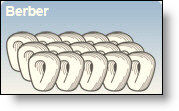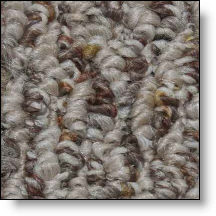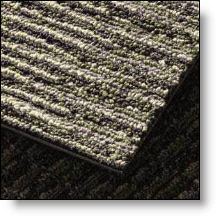Berber carpet
 A berber carpet is a popular carpet used in many situations today. The name berber relates to the weave of a carpet. The label berber carpet does not denote the type of a carpet (see carpet types), but it is a type of weave of a carpet (see carpet style). A berber carpet can be purchased in many different carpet fiber types, such as nylon, polyester, wool, olefin, and some others (see carpet fiber).
A berber carpet is a popular carpet used in many situations today. The name berber relates to the weave of a carpet. The label berber carpet does not denote the type of a carpet (see carpet types), but it is a type of weave of a carpet (see carpet style). A berber carpet can be purchased in many different carpet fiber types, such as nylon, polyester, wool, olefin, and some others (see carpet fiber).
Berber carpet advantages
 Probably the most important advantage of a berber carpet is its price. Because of the berber carpet ease of manufacture, berber carpets are relatively inexpensive. Berber carpets are often economically priced in comparison to other weave styles of carpet. Low-end berber carpet products can cost from $2-$6/square foot. Expensive berber carpets made of wool can cost over $10/square foot. For prices, see carpet manufacturers.
Probably the most important advantage of a berber carpet is its price. Because of the berber carpet ease of manufacture, berber carpets are relatively inexpensive. Berber carpets are often economically priced in comparison to other weave styles of carpet. Low-end berber carpet products can cost from $2-$6/square foot. Expensive berber carpets made of wool can cost over $10/square foot. For prices, see carpet manufacturers.
Because the berber carpet type is wide-spread and popular, berber carpets are produced in a range of colors and finishes. The advantage of a berber carpet is its wide availability of styles and colors.
In general, berber carpet is relatively fairly easy to maintain with regular vacuuming. The downside of a berber carpet is that dust and small particles can get stuck in the berber carpets dense loops which means that a regular cleaning schedule is a must (high traffic areas require daily vacuuming), but on the other hand vacuuming is easy.
Berber carpet disadvantages
The berber carpet weave itself is a good choice, but many berber carpets today have problems due to the combination of the berber weave and the fiber type. Many berber carpets are made out of Olefin or PET (a polyethylene terephthalate). The choice of the combination of berber weave and the Olefin or PET fiber is not a good choice. If a berber carpet is made out of olefin, it can be a health hazard. Olefin has a low flash point. Olefin actually has one of the lowest flash points of any floor covering materials, 170 degrees Fahrenheit and therefore it burns at a very low point. Olefin is also not very durable, so for example if you drag a heavy piece of furniture across your olefin berber carpet, your berber carpet will have scorch marks left on it.
If a berber carpet is made out of olefin, it can be a health hazard. Olefin has a low flash point. Olefin actually has one of the lowest flash points of any floor covering materials, 170 degrees Fahrenheit and therefore it burns at a very low point. Olefin is also not very durable, so for example if you drag a heavy piece of furniture across your olefin berber carpet, your berber carpet will have scorch marks left on it.
Another bad characteristic of a berber carpet is that it is notorious for raveling at the edges. A common situation is that a small piece of the berber carpet gets hooked on a ladies' high heel, or the berber carpet can get also damaged easily by dog or car claws.
Because of the loop that is inherent to the berber weave, berber carpet is the hardest carpet to keep clean. The problem is that the dirt falls to the bottom of the berber carpet fibers and gets trapped there because of the loop weave and the twist of the loop being larger at the top than the bottom.